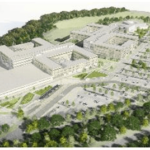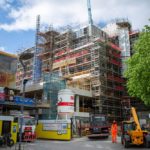News - Construction News
Updating the NHS Maintenance estate standard

How everyday need can combat infrastructure delays
Amit Vadgama, principal building surveyor at Pick Everard, discusses the everyday NHS maintenance that is contributing positively to our communities, amid infrastructure spending concerns and hospital building delays.
Outdated, dilapidated and in need of investment. These were the challenges lobbied at the Conservative government when it launched its Health Infrastructure Plan in October 2020. Since then, and through the weight of the pandemic, the construction industry has been tasked with tackling a rising NHS maintenance backlog, which currently stands at £11.6Bn.
Following a change of government, adding further to sector concerns is the recent announcement from Chancellor Rachel Reeves, which has placed the build of 40 new hospitals on pause, subject to government review. With 2000 buildings on the NHS estate older than the NHS itself and reinforced autoclaved aerated concrete (RAAC) still top of infrastructure concerns, tensions are heightened for patients and staff.
While hospitals require urgent attention to carry out emergency work, there is also a clear mandate for the construction industry to attend to the vital maintenance services within local health centres and facilities. These are an important part of the required infrastructure overhaul and will arguably play a more central role to addressing the nation’s health while the £40Bn hospital programme is placed on pause.
Part of healthcare remits is to keep hubs of community health operational, particularly during times of urgent care. The pandemic only shone further light on how integral our medical professionals and healthcare centres are to this mission, often opening or working for extended hours, or adapted in times of need.
As well as balancing this extra requirement of services with its everyday care, increased pressure and dependence was placed on components such as boilers, which are indispensable to the effective running of the facilities, while insulation and lighting maintenance were also key for extended operations. These systems continue to be the focus of work in the bid to help transform the NHS estate, while larger infrastructure changes are placed on pause.
Funding shortfall
Historically, the biggest obstacle facing local authorities in the past has been cost. The latest Labour announcement will have no doubt raised further eyebrows in this area, but with a rising backlog, there is clearly an ever-present need to implement lasting changes where possible.
Often, facilities require not just big component changes, such as boiler replacement, but also everyday improvements that make a huge difference to modern healthcare standards. Contractors must be aware of how they can make these improvements, but also undertake them in live environments, operating with a degree of flexibility and detailed pre-planning to ensure they maintain sterile conditions.
Gutter cleaning, fire alarm replacement and window repairs are elements that often go unnoticed in this area but play a huge role in ensuring healthcare facilities remain operational. Changes are also being driven by sustainability remits, with elements like LED lighting helping to not only brighten environments and cut carbon, but also reduce overhead costs in times of need.
Setting regional standards
Improvements also have an influential nature across local authorities. Switching to more efficient lighting and heating is not just positive PR, it creates a benchmark for other councils to follow suit. Cross collaboration, or influence in this manner is only a constructive step on the pathway to a brighter future.
We must also ensure no gaps are felt within communities, which can often feel aggrieved when funding is prioritised unevenly between districts, or in new areas of healthcare over existing, valued infrastructure.
A community first approach
New facilities within the healthcare sector often attract the headlines, simply due their inherent ability to start from scratch and build with forward thinking technology front and centre of design approaches. For example, many new healthcare facilities are incorporating green heating solutions, such as heat pumps, while no-touch technology has seen massive expansion from the lessons of the pandemic.
However, with this now placed on pause, it is vital within the healthcare conversation that we do not forget about our local practices, and the hardworking professionals and patients they support. Incremental improvements add up to a greater sum of their parts, and by taking the time to fix leaking gutters, or inefficient lighting, the sector is making small gains in the wider quest to overhaul the NHS Estates catalogue. Importantly, the work acts as a cost efficient stopgap while spending budgets are reviewed at a national level.
We must continue to engage with local authorities on their healthcare requirements, driven by an ambition to collaborate on maintenance improvements that ultimately drive value at the heart of our communities, and build a safe and healthy future for all.
If you would like to read more stories like this, then please click here
Related Articles
More News
- UK Introduces New Trade Measures to Support Steel Sector
11 Jul 25
Steel producers across the UK will benefit from stronger trade measures from 1 July.
- Clean energy future to be ‘built in Britain’
10 Jul 25
The Clean Energy Industries Sector Plan comes into force to ‘build it in Britain’.
- Thousands more to get the tools they need to start construction careers
9 Jul 25
Thousands of people are set to benefit from on-the-job training and career opportunities in the






